Author's Note: It's Day 4 of "The Summer Sucks! Showcase"! Today I'm letting you guys take a look at my review for Paper Mario: Sticker Star for Nintendo 3DS. I actually am not sure if I agree with my review anymore, given that I wrote this shortly after the game came out last November, but I'm interested in knowing what you think in the comments below!
I apologize beforehand about the captions for the screenshots in this post and in future posts. Wordpress just altered their entire layout and everything got messed up. So while I try to work on a fix, please bear with me! Thanks a bunch. After messing around with some code, I've finally gotten my captions to work! Thanks for "sticking" with me! Aha.
To learn more about my "The Summer Sucks! Showcase" blog series, click here to read the announcement page.
Stuck between the pages.
When it was revealed that Sticker Star would strip away many of the RPG elements the series has been known for and replace them with "stickers," fans of Paper Mario let out a collective sigh. After the somewhat disappointing Super Paper Mario on Wii, all we wanted was a game similar to the original Paper Mario on N64, or a follow-up to its spectacular sequel, Paper Mario: The Thousand-Year Door on the GameCube. But Nintendo will have none of that. Sticker Star is an ambitious and bold move for the franchise to be sure, but does the risk pay off, or should Sticker Star have been better off left on the drawing board?
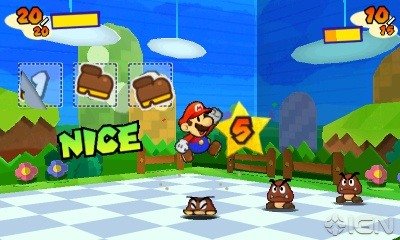
Does this new approach "stick"? Haha, get it? Never mind.
Though the Paper Mario series has been known for its strict RPG elements, Sticker Star takes a more casual-friendly approach by introducing "stickers." These stickers can act as either in-battle attack moves or environmental puzzle solutions, depending on when, where, and how you use them. Stickers are littered everywhere in the game world, and you'll rarely find yourself out of them. In fact, you're more likely to be out of the right stickers (more on that later) than be without stickers at all. Also scattered around the game world are "things," real-world items that have fallen into the Mushroom Kingdom. These "things" can be turned into stickers at the game's town square and function much in the same way normal stickers do.
Like most RPG's, battle is engaged when you come in contact with an opponent on the field. In battle, stickers are used as attacks against your opponent. Each sticker can only be used once, so once you've used them, they're gone. This is especially frustrating when you fail to execute an attack correctly, or use the wrong sticker on accident, as there's no way to recover them immediately. What's worse is that there is no leveling system in Sticker Star, so the only reward you get is a bit of in-game currency.
This frustration carries over to the boss battles, many of which require very specific "thing" stickers to defeat. Like, very specific. One boss battle requires you to use a fishhook sticker, which can only be found under a secret area in a hidden level. It would be fine if these secrets were used only to facilitate gameplay, but when finding secrets becomes a requirement, it simply becomes a hassle.
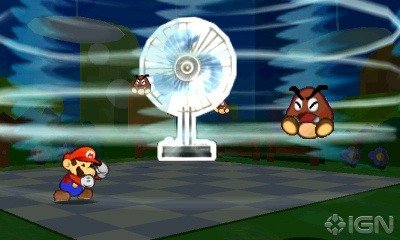
Wheeeeeeeeeeee!!!!
But not everything about the battle system rubs off as awful thoughtlessness. Surprisingly, there are many minute details about the battle system that makes you reflect on just how much detail was put into this game. For example, initiating a battle in poison water will result in both you and your opponent losing your health little by little over time. Or in some levels, enemies fold themselves into cones, forcing players to use other tactics other than the usual "jump" attack to inflict damage.
As I mentioned before, stickers can also be used to solve environmental puzzles, which is the chief way for players to progress through the game. Solving these puzzles require you to "paperize," or transform your game world into a flat piece of paper and carefully select a sticker to stick onto the level area. For instance, a radiator sticker may be used to melt snow in your way, or a fan sticker may be used to spin a windmill and reveal a hidden door. Many of these puzzles are clever and fun, and they bring about a sense of satisfaction once you solve them, much like in the Zelda games.
One downside to these puzzles is the fact that the game punishes you for experimentation. There are many instances in which the game doesn't tell you what specific sticker to use, and when you use the wrong one, it takes that sticker away from you. And the game doesn't even give you any hints as to which sticker to use either. One puzzle required you to get rid of a tornado, with your only hint being an electric outlet. Naturally, I went with the fan sticker, one of the first stickers you find in the game. Turns out I was wrong, and the game in fact was actually looking for a vacuum sticker, which was off in a whole other world. And those 200 coins I used to purchase that fan sticker in the first place? Gone.
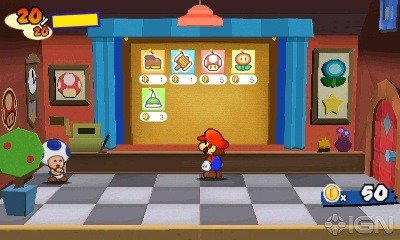
Good thing Battle Stickers aren't that expensive though!
Now, it may seem like that I have some sort of bitter hatred toward the game based off of what you've read so far, but I actually don't. Quite the opposite in fact. Sticker Star does have its issues, but many of them can be overlooked when you take Sticker Star's other elements into account.
Let's talk about the level structure, shall we? Instead of a large open world like in the original Paper Mario or The Thousand-Year Door, Sticker Star uses a level structure reminiscent of Super Mario World, of all things. In my opinion, this is a dramatic step forward in the right direction. Backtracking in the previous games often took much more time than it should, and with the ability to jump around from level to level at will is a wonderful addition to the series.
Sticker Star also shines in its presentation. Each world is crafted into paper dioramas that look great in 3D. The jazzy music fits perfectly with the game, and its graphical style is just simply adorable. The humor we've all come to associate with Paper Mario is still there as well, but this time it's full of paper and sticker jokes. With the exception of Kersti (your lone helper who is, let's face it, completely useless) every character in the game only complements its already high presentation value. Couple that with details like shifting your 3DS to make shiny stickers shimmer, or shaking your 3DS to make the HUD sway, and you've got the perfect game-toy to play with.
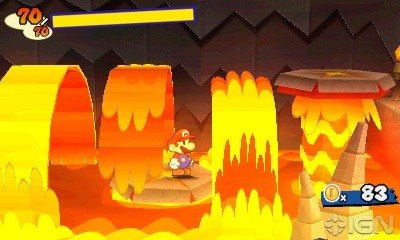
Cool environments like this is what make Sticker Star shine.
In some cases, Sticker Star may seem broken. You'll find puzzles that will frustrate you, and you'll find boss fights that will make you question the series' unique approach to the genre. But when the battles go right and the mechanics make sense, the game's charm and personality really does shine through. The feeling you get after solving the game's many puzzles is simply just so satisfying. Yes, it's a game that admittedly has many problems, but it's also a game that has many merits.
In fact, I wouldn't really have a problem recommending this game. It's a wonderful new direction for Paper Mario, just executed a bit awkwardly. Sticker Star had the potential to be as amazing as The Thousand-Year Door. It had the potential to blow my mind. And what's there is great. It's just disappointing that it didn't turn out to be as amazing as I'd hoped.
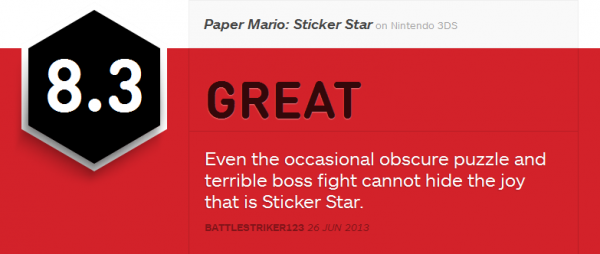
![Amazing Spider-Man Finale Features New [SPOILER] Costume](../../../../../../assets1.ignimgs.com/2018/06/01/untitled-br-1527892808294_small.jpg)